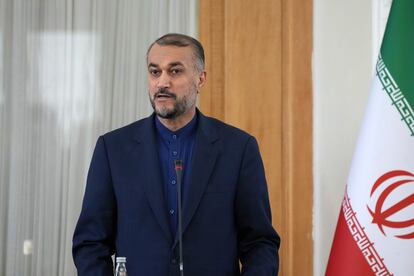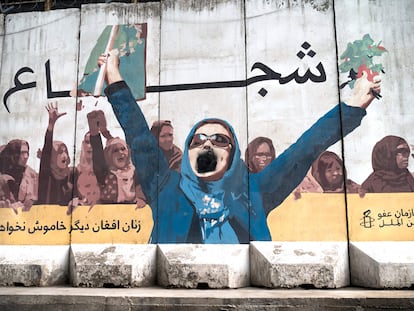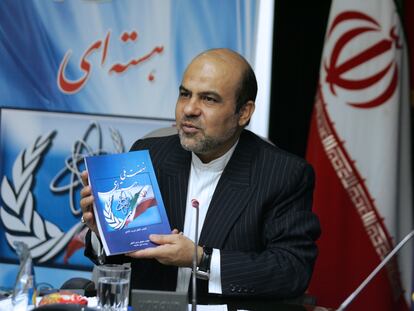Iran says drone attack targets defense facility in Isfahan
The Iranian Defense Ministry offered no information on who it suspected carried out the attack

Bomb-carrying drones targeted an Iranian defense factory in the central city of Isfahan overnight, authorities said early Sunday, causing some damage at the plant amid heightened regional and international tensions engulfing the Islamic Republic.
The Iranian Defense Ministry offered no information on who it suspected carried out the attack, which came as a refinery fire separately broke out in the country’s northwest and a 5.9 magnitude earthquake struck nearby, killing three people.
However, Tehran has been targeted in suspected Israeli drone strikes amid a shadow war with its Mideast rival as its nuclear deal with world powers collapsed. Meanwhile, tensions also remain high with neighboring Azerbaijan after a gunman attacked that country’s embassy in Tehran, killing its security chief and wounding two others.
Details on the Isfahan attack, which happened around 11.30pm Saturday, remained scarce. A Defense Ministry statement described three drones being launched at the facility, with two of them successfully shot down. A third apparently made it through to strike the building, causing “minor damage” to its roof and wounding no one, the ministry said.
The state-run IRNA news agency later described the drones as “quadcopters equipped with bomblets.” Quadcopters, which get their name from having four rotors, typically operate from short ranges by remote control.
Iranian state television’s English-language arm, Press TV, aired mobile phone video apparently showing the moment that drone struck along the busy Imam Khomeini Expressway that heads northwest out of Isfahan, one of several ways for drivers to go to the holy city of Qom and Tehran, Iran’s capital. A small crowd stood gathered, drawn by anti-aircraft fire, watching as an explosion and sparks struck a dark building.
“Oh my God! That was a drone, wasn’t it?” the man filming shouts. “Yeah, it was a drone.”
Those there fled after the strike.
That footage of the strike, as well as footage of the aftermath analyzed by The Associated Press, corresponded to a site on Minoo Street in northwestern Isfahan that’s near a shopping center that includes a carpet and an electronics store.
Iranian defense and nuclear sites increasingly find themselves surrounded by commercial properties and residential neighborhoods as the country’s cities sprawl ever outward. Some locations as well remain incredibly opaque about what they produce, with only a sign bearing a Defense Ministry or paramilitary Revolutionary Guard logo.
The Defense Ministry only called the site a “workshop,” without elaborating on what it made. Isfahan, some 350 kilometers (215 miles) south of Tehran, is home to both a large air base built for its fleet of American-made F-14 fighter jets and its Nuclear Fuel Research and Production Center.
The attack comes after Iran’s Intelligence Ministry in July claimed to have broken up a plot to target sensitive sites around Isfahan. A segment aired on Iranian state TV in October included purported confessions by alleged members of Komala, a Kurdish opposition party that is exiled from Iran and now lives in Iraq, that they planned to target a military aerospace facility in Isfahan after being trained by Israel’s Mossad intelligence service.
Activists say Iranian state TV has aired hundreds of coerced confessions over the last decade. Israeli officials declined to comment on the attack.
Meeting later alongside his Qatari counterpart, Iranian Foreign Minister Hossein Amirabdollahian criticized the “cowardly attack” when asked if it would affect the country’s nuclear program.
“Such moves can’t impact our nuclear scientists will and intentions to achieve peaceful nuclear energy,” Amirabdollahian said.
Qatar’s Foreign Minister Sheikh Mohammed bin Abdulrahman Al Thani said he passed a message from the Americans to Iran that related to its nuclear program, without offering specifics.
Separately, Iran’s state TV said a fire broke out at an oil refinery in an industrial zone near the northwestern city of Tabriz. It said the cause was not yet known, as it showed footage of firefighters trying to extinguish the blaze. Tabriz is some 520 kilometers (325 miles) northwest of Tehran.
State TV also said the magnitude 5.9 earthquake killed three people and injured 816 others in rural areas in West Azerbaijan province, damaging buildings in many villages.
Iran’s theocratic government faces challenges both at home and abroad as its nuclear program rapidly enriches uranium closer than ever to weapons-grade levels since the collapse of its atomic accord with world powers.
Nationwide protests have shaken the country since the September death of Mahsa Amini, a Kurdish-Iranian woman detained by the country’s morality police. Its rial currency has plummeted to new lows against the US dollar. Meanwhile, Iran continues to arm Russia with the bomb-carrying drone that Moscow uses in attacks in Ukraine on power plants and civilian targets.
Israel is suspected of launching a series of attacks on Iran, including an April 2021 assault on its underground Natanz nuclear facility that damaged its centrifuges. In 2020, Iran blamed Israel for a sophisticated attack that killed its top military nuclear scientist.
Israeli officials rarely acknowledge operations carried out by the country’s secret military units or its Mossad intelligence agency. However, Israeli Prime Minister Benjamin Netanyahu, who recently re-entered the premiership, long has considered Iran to be the biggest threat his nation faces. The US and Israel also just held their largest-ever military exercise amid the tensions with Iran.
Meanwhile, tensions remain high between Azerbaijan and Iran as Azerbaijan and Armenia have fought over the Nagorno-Karabakh region. Iran also wants to maintain its 44-kilometer (27-mile) border with landlocked Armenia – something that could be threatened if Azerbaijan seizes new territory through warfare.
Iran in October launched a military exercise near the Azerbaijan border. Azerbaijan also maintains close ties to Israel, which has infuriated Iranian hard-liners, and has purchased Israeli-made drones for its military.
Anwar Gargash, a senior Emirati diplomat, warned online that the Isfahan attack represented one more event in the “dangerous escalation the region is witnessing.” The United Arab Emirates was targeted in missile and drone attacks last year claimed by Yemen’s Iran-backed Houthi rebels.
It “is not in the interest of the region and its future,” Gargash wrote on Twitter. “Although the problems of the region are complex, there is no alternative to dialogue.”
Sign up for our weekly newsletter to get more English-language news coverage from EL PAÍS USA Edition
Tu suscripción se está usando en otro dispositivo
¿Quieres añadir otro usuario a tu suscripción?
Si continúas leyendo en este dispositivo, no se podrá leer en el otro.
FlechaTu suscripción se está usando en otro dispositivo y solo puedes acceder a EL PAÍS desde un dispositivo a la vez.
Si quieres compartir tu cuenta, cambia tu suscripción a la modalidad Premium, así podrás añadir otro usuario. Cada uno accederá con su propia cuenta de email, lo que os permitirá personalizar vuestra experiencia en EL PAÍS.
¿Tienes una suscripción de empresa? Accede aquí para contratar más cuentas.
En el caso de no saber quién está usando tu cuenta, te recomendamos cambiar tu contraseña aquí.
Si decides continuar compartiendo tu cuenta, este mensaje se mostrará en tu dispositivo y en el de la otra persona que está usando tu cuenta de forma indefinida, afectando a tu experiencia de lectura. Puedes consultar aquí los términos y condiciones de la suscripción digital.
More information
Archived In
Últimas noticias
Sydney Sweeney, the actress praised by Trump: ‘Women are up against what society wants them to be’
The Bolsonaro surname: An advantage or liability in Brazil’s 2026 presidential elections?
Raúl Rocha, from jet-setting with Miss Universe to arms trafficking and fuel theft
80,000 barrels of Mexican oil sent to Cuba: Havana drawn into the US–Mexico clash
Most viewed
- Reinhard Genzel, Nobel laureate in physics: ‘One-minute videos will never give you the truth’
- Pablo Escobar’s hippos: A serious environmental problem, 40 years on
- Charles Dubouloz, mountaineering star, retires at 36 with a farewell tour inspired by Walter Bonatti
- Why we lost the habit of sleeping in two segments and how that changed our sense of time
- The fall of a prolific science journal exposes the billion-dollar profits of scientific publishing










































